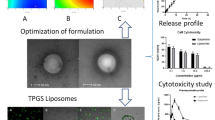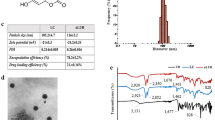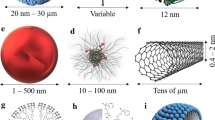Abstract
The objective of this research was to develop vitamin E oil (VEO)-loaded liposomes for intravenous delivery and to study the VEO effect on melphalan (MLN) loading, release, and stability. Further, the research aim was to determine the in vitro anticancer activity and in vivo systemic toxicity of MLN and simvastatin (SVN) combinations, for repurposing SVN in multiple myeloma. The liposomes were prepared by thin-film hydration technique. The optimized liposomes were surface modified with Pluronic F108, lyophilized, and evaluated for mean particle size, MLN content and release behavior, and in vitro hemolysis, cytotoxicity, and macrophage uptake characteristics. Further, in vivo acute toxicity of plain MLN + SVN combination was determined in comparison to their liposomal combination. The VEO alone and in combination with D-α-tocopheryl polyethylene glycol 1000 succinate (TPGS) has significantly increased the MLN and SVN loading. The reconstituted liposomes showed the mean particle size below 200 nm (cryo-transmission electron microscope analysis also revealed the liposome formation). In presence of VEO, the liposomes have shown substantially controlled drug release, lower hemolysis, sustained cytotoxicity, lower phagocytosis, and moderately improved chemical stability. Besides, the effect of liposomal combination on mice bodyweight is found substantially lower than the plain drug combination. In conclusion, the VEO could be used along with phospholipids and cholesterol to develop liposomal drugs with improved physicochemical characteristics. Further, the interesting cytotoxicity study results indicated that SVN could be repurposed in combination with anticancer drug MLN against multiple myeloma; liposomal drugs could be preferred to obtain improved efficacy with decreased systemic toxicity.






Similar content being viewed by others
References
Gajek A, Poczta A, Łukawska M, Adamczewska VC, Tobiasz J, Marczak A. Chemical modification of melphalan as a key to improving treatment of haematological malignancies. Sci Rep. 2020;10(1):4479.
Mateos MV, San Miguel JF. Management of multiple myeloma in the newly diagnosed patient. Hematology Am Soc Hematol Educ Program. 2017;2017(1):498–507.
Chen Y, Jia Y, Song W, Zhang L. Therapeutic potential of nitrogen mustard based hybrid molecules. Front Pharmacol. 2018;9:1453.
Kuczma M, Ding ZC, Zhou G. Immunostimulatory effects of melphalan and usefulness in adoptive cell therapy with antitumor CD4+ T cells. Crit Rev Immunol. 2016;36(2):179–91.
Gourzones C, Bellanger C, Lamure S, Gadacha QK, De Paco EG, Vincent L, Cartron G, Klein B, Moreaux J. Antioxidant defenses confer resistance to high dose melphalan in multiple myeloma cells. Cancers (Basel). 2019;11(4):439.
Hu X, Wang Y, Xue J, Han T, Jiao R, Li Z, Liu W, Xu F, Hua H, Li D. Design and synthesis of novel nitrogen mustard-evodiamine hybrids with selective antiproliferative activity. Bioorg Med Chem Lett. 2017;27(22):4989–93.
More GS, Thomas AB, Chitlange SS, Nanda RK, Gajbhiye RL. Nitrogen mustards as alkylating agents: a review on chemistry, mechanism of action and current USFDA status of drugs. Anticancer Agents Med Chem. 2019;19(9):1080–102.
Lecourt GV, Carvajal JC, Villalobos FA, Egaña FS, Martín IMS, Duggon JB, Fuentealba D. Encapsulation of chemotherapeutic drug melphalan in Cucurbit[7]uril: effects on its alkylating activity, hydrolysis, and cytotoxicity. ACS Omega. 2018;3(7):8337–43.
Boschmans J, De Bruijn E, Van Schil P, Lemiere F. Analysis of novel melphalan hydrolysis products formed under isolated lung perfusion conditions using liquid chromatography/tandem mass spectrometry. Rapid Commun Mass Spectrom. 27(7):835–841.
Huang L, Cheah V, Chan D, Marzan F, Dvorak CC, Aweeka FT, Boyle JL. Determination of melphalan in human plasma by UPLC-UV method. Cancer Chemother Pharmacol. 2019;83(5):905–10.
Rudhrabatla VSAP, Sudhakar B, Reddy KVSN. In vitro and in vivo assessment of designed melphalan loaded stealth solid lipid nanoparticles for parenteral delivery. BioNanoSci. 2020;10:168–90.
Meyer R, Sonnen AFP, Nau WM. Phase-dependent lateral diffusion of α-tocopherol in DPPC liposomes monitored by fluorescence quenching. Langmuir. 2010;26(18):14723–9.
Suntres ZE. Liposomal antioxidants for protection against oxidant-induced damage. J Toxicol. 2011;2011:152474.
Urano S, Kitahara M, Kato Y, Hasegawa Y, Matsuo M. Membrane stabilizing effect of vitamin E: existence of a hydrogen bond between α-tocopherol and phospholipids in bilayer liposomes. J Nutr Sci Vitaminol. 1990;36(6):513–9.
Verdon CP, Blumberg JB. Influence of dietary vitamin E on the intermembrane transfer of α-tocopherol as mediated by an α-tocopherol binding protein. Proc Soc Exp Biol Med. 1988;189(1):52–60.
Cereda CMS, Tófoli GR, Junior RBDB, de Jesus MB, Fraceto LF, Groppo FC, de Araujo DR, de Paula E. Stability and local toxicity evaluation of a liposomal prilocaine formulation. J Liposome Res. 2008;18(4):329–39.
Lee WC, Tsai TH. Preparation and characterization of liposomal coenzyme Q10 for in vivo topical application. Int J Pharm. 2010;395(1–2):78–83.
Onishi H, Machida Y, Machida Y. Antitumor properties of irinotecan-containing nanoparticles prepared using poly(DL-lactic acid) and poly(ethylene glycol)-block-poly(propylene glycol)-block-poly(ethylene glycol). Biol Pharm Bull. 2003;26(1):116–9.
Kunii R, Onishi H, Machida Y. Preparation and antitumor characteristics of PLA/(PEG-PPG-PEG) nanoparticles loaded with camptothecin. Eur J Pharm Biopharm. 2007;67(1):9–17.
Kunii R, Onishi H, Ueki KI, Koyama KI, Muchida Y. Particle characteristics and biodistribution of camptothecin-loaded PLA/(PEGPPG-PEG) nanoparticles. Drug Delv. 2008;15(1):3–10.
Duarte JA, de Barros ALB, Leite EA. The potential use of simvastatin for cancer treatment: a review. Biomed Pharmacother. 2021;141:111858.
Bello ED, Zwergel C, Mai A, Valente S. The innovative potential of statins in cancer: new targets for new therapies. Front Chem. 2020;8:516.
Barbalata CI, Tefas LR, Achim M, Tomuta I, Porfire AS. Statins in risk-reduction and treatment of cancer. World J Clin Oncol. 2020;11(8):573–88.
Bandgar SA, Jadhav NR, Manjappa AS. A remarkable in vitro cytotoxic, cell cycle arresting and proapoptotic characteristics of low-dose mixed micellar simvastatin combined with alendronate sodium. Drug Deliv Transl Res. 2020;10(4):1122–35.
Manjappa AS, Goel PN, Vekataraju MP, Kesarla RS, Kinjal M, Mukesh U, Nikam Y, Gude RP, Murthy RSR. Is an alternative drug delivery system needed for docetaxel? The role of controlling epimerization in formulations and beyond. Pharm Res. 2013;30(10):2675–93.
Mahmoudi R, Hassandokht F, Ardakani MT, Karimi B, Roustazadeh A, Tarvirdipour S, Barmak MJ, Nikseresht M, Baneshi M, Mousavizadeh A, Shirazi MS, Alipour M, Bardania H. Intercalation of curcumin into liposomal chemotherapeutic agent augments apoptosis in breast cancer cells. J Biomater Appl. 2021;35(8):1005–18.
Kumbhar PS, Diwate SK, Mali UG, Shinde TU, Disouza JI, Manjappa AS. Development and validation of RP-HPLC method for simultaneous estimation of docetaxel and ritonavir in PLGA nanoparticles. Ann Pharm Fr. 2020;78(5):398–407.
Guimarães D, Noro J, Silva C, Cavaco-Paulo A, Nogueira E. Protective effect of saccharides on freeze-dried liposomes encapsulating drugs. Front Bioeng Biotechnol. 2019;7:424.
Bellare JR, Davis HT, Scriven LE, Talmon Y. Controlled environment vitrification system: an improved sample preparation technique. J Electron Microsc Tech. 1988;10(1):87–111.
Kumar KK, Nadh RV. A validated RP-HPLC method for the estimation of melphalan in tablet dosage forms. Rasayan J Chem. 2011;4(4):863–7.
Unnam S, Panduragaiah VM, Sidramappa MA, Muddana Eswara BR. Gemcitabine-loaded folic acid tagged liposomes: improved pharmacokinetic and biodistribution profile. Curr Drug Deliv. 2019;16(2):111–122 2.
Kumbhar PS, Sakate AM, Patil OB, Manjappa AS, Disouza JI. Podophyllotoxin-polyacrylic acid conjugate micelles: improved anticancer efficacy against multidrug-resistant breast cancer. J Egypt Natl Canc Inst. 2020;32(1):42.
Weber C, Voigt M, Simon J, Danner AK, Frey H, Mailänder V, Helm M, Morsbach S, Landfester K. Functionalization of liposomes with hydrophilic polymers results in macrophage uptake independent of the protein corona. Biomacromol. 2019;20(8):2989–99.
Zarrabi A, Abadi MAA, Khorasani S, Mohammadabadi MR, Jamshidi A, Torkaman S, Taghavi E, Mozafari MR, Rasti B. Nanoliposomes and tocosomes as multifunctional nanocarriers for the encapsulation of nutraceutical and dietary molecules. Molecules. 2020;25(3):638.
Flores GT, Horta AG, Cantu YIV, Rodriguez C, Garcia AR. Preparation and characterization of liposomal everolimus by thin-film hydration technique. Adv Polym Technol. 2020;2020:1–9.
Marsanasco M, Márquez AL, Wagner JR, Alonso SDV, Chiaramoni NS. Liposomes as vehicles for vitamins E and C: an alternative to fortify orange juice and offer vitamin C protection after heat treatment. Food Res Int. 2011;44(9):3039–46.
Padamwar MN, Pokharkar VB. Development of vitamin loaded topical liposomal formulation using factorial design approach: drug deposition and stability. Int J Pharm. 2006;320(1–2):37–44.
Laouini A, Charcosset C, Fessi H, Holdich RG, Vladisavljevic GT. Preparation of liposomes: a novel application of microengineered membranes - investigation of the process parameters and application to the encapsulation of vitamin E. RSC Adv. 2013;3(15):4985–94.
Guan Y, Wang LY, Wang B, Ding MH, Bao YL, Tan SW. Recent advances of d-α-tocopherol polyethylene glycol 1000 succinate based stimuli-responsive nanomedicine for cancer treatment. Curr Med Sci. 2020;40(2):218–31.
Luiz MT, Di Filippo LD, Alves RC, Araújo VHS. Duarte JL, Marchetti JM, Chorilli M. The use of TPGS in drug delivery systems to overcome biological barriers. Eur Polym J. 2021;142:110129.
Caracciolo G. Clinically approved liposomal nanomedicines: lessons learned from the biomolecular corona. Nanoscale. 2018;10(9):4167–72.
Jin X, Yang Q, Zhang Y. Synergistic apoptotic effects of apigenin TPGS liposomes and tyroservatide: implications for effective treatment of lung cancer. Int J Nanomedicine. 2017;12:5109–18.
Kurmi BD, Paliwal SR. Development and optimization of TPGS based stealth liposome of doxorubicin using box-behnken design: characterization, hemocompatibility and cytotoxicity evaluation in breast cancer cells. J Liposome Res. 2021;1–46.
Ickenstein LM, Arfvidsson MC, Needham D, Mayer LD, Edwards K. Disc formation in cholesterol-free liposomes during phase transition. Biochim Biophys Acta. 2003;1614(2):135–8.
Lakkadwala S, Singh J. Co-delivery of doxorubicin and erlotinib through liposomal nanoparticles for glioblastoma tumor regression using an in vitro brain tumor model. Colloids Surf B Biointerfaces. 2019;173:27–35.
Chauhan D, Anderson KC. Mechanisms of cell death and survival in multiple myeloma (MM): therapeutic implications. Apoptosis. 2003;8(4):337–43.
Robaka P, Drozdzb I, Szemrajc J, Robakd T. Drug resistance in multiple myeloma. Cancer Treat Rev. 2018;70:199–208.
Jain A, Chasoo G, Singh SK, Saxena AK, Jain SK. Transferrin-appended PEGylated nanoparticles for temozolomide delivery to brain: in vitro characterization. J Microencapsul. 2011;28(1):21–8.
Chaudhari KR, Ukawala M, Manjappa AS, Kumar A, Mundada PK, Mishra AK, Mathur R, Mönkkönen J, Murthy RSR. Opsonization, biodistribution, cellular uptake and apoptosis study of PEGylated PBCA nanoparticle as potential drug delivery carrier. Pharm Res. 2012;29(1):53–68.
Beltrán-Gracia E, López-Camacho A, Higuera-Ciapara I, Velázquez-Fernández JB, Vallejo-Cardona AA. Nanomedicine review: clinical developments in liposomal applications. Cancer Nano. 2019;10:11.
Inglut CT, Sorrin AJ, Kuruppu T, Vig S, Cicalo J, Ahmad H, Huang HC. Immunological and toxicological considerations for the design of liposomes. Nanomaterials (Basel). 2020;10(2):190.
Acknowledgements
The authors thank Cipla Pvt. Ltd. Goa and Biotechnic, Mumbai, for gifting melphalan and simvastatin, respectively. We also thank Lipoid GmbH, Germany, for giving hydrogenated soya bean phosphatidylcholine (HSPC) as a gift sample. Our special thanks to Dr. Yogisha S, the Director, Skanda Life Sciences Pvt. Ltd., Bangalore, for providing lab facilities to carry out all cell culture and animal experiments and LCMS/MS facility. The authors also acknowledge the timely assistance of the Chemical Engineering cryo-HRTEM Central Facility of IRCC, IIT Bombay.
Author information
Authors and Affiliations
Contributions
Unnam Sambamoorthy: Investigation, conceptualization, and original draft preparation. Arehalli S. Manjappa: Conceptualization, supervision, and original draft preparation. Bhanoji Rao Muddana Eswara: Supervision and reviewing and editing of original draft. Arun Kumar Sanapala: Methodology and resources. Naidu Nagadeepthi: Resources and validation.
Corresponding authors
Ethics declarations
Conflict of Interest
The authors declare no competing interests.
Additional information
Publisher's Note
Springer Nature remains neutral with regard to jurisdictional claims in published maps and institutional affiliations.
Supplementary Information
Below is the link to the electronic supplementary material.
Rights and permissions
About this article
Cite this article
Sambamoorthy, U., Manjappa, A.S., Eswara, B.R.M. et al. Vitamin E Oil Incorporated Liposomal Melphalan and Simvastatin: Approach to Obtain Improved Physicochemical Characteristics of Hydrolysable Melphalan and Anticancer Activity in Combination with Simvastatin Against Multiple Myeloma. AAPS PharmSciTech 23, 23 (2022). https://doi.org/10.1208/s12249-021-02177-6
Received:
Accepted:
Published:
DOI: https://doi.org/10.1208/s12249-021-02177-6




